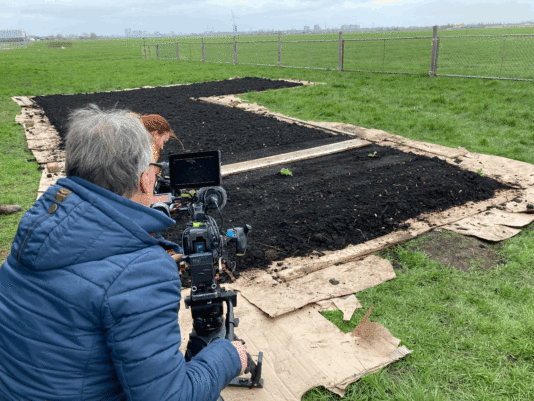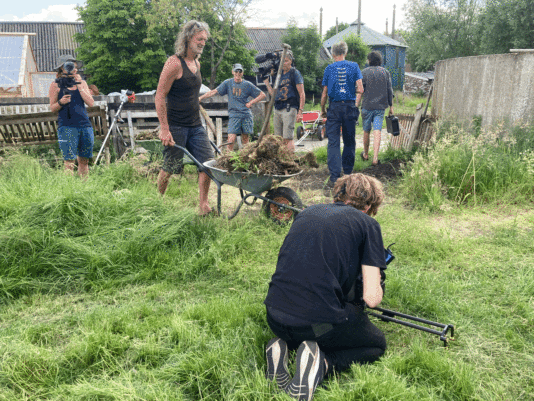- About
- Topics
- Story
- In-Depth
- Picks
- Opinion
- News
- Donate
- Signup for our newsletterOur Editors' Best Picks.Send
Read, Debate: Engage.
| June 26, 2024 | |
|---|---|
| topic: | Sustainable Agriculture |
| tags: | #documentary, #soil health, #Sustainable Agriculture, #In Focus |
| located: | Netherlands |
| by: | FairPlanet Editorial Team |
On a recent In Focus episode, FairPlanet's Nour Ghantous spoke with Mark Verkerk who directed a new documentary titled Planet Soil.
The film tells a beautiful story about soil, life, regenerative agriculture and the interconnectedness of them all through stunning footage of underground life like you've never seen before.
Verkerk has over 30 years of experience in filmmaking and has written and directed several award winning documentaries, including some featured in the National Geographic. Below is a glimpse into their conversation.
FairPlanet readers can enjoy a discount on the film by using the code FAIRPLANET at this link.
The transcript has been edited for clarity and brevity.
FairPlanet: Mark, it's a pleasure to have you here today. Can you tell us a bit about the inspiration behind your 'Planet Soil' documentary?
Mark Verkerk: Making films on nature is something that is has been a focus of my in the last 15 years or so. And soil is has been a subject that's been getting more and more attention; I felt that we should be making a film about it. then about four years ago, we were approached by the IUCN, an international conservation organisation that was looking to get people more connected to soil.
And that sort of provided the impetus to dig into the techniques and technology in order to make the film possible.
How does Planet Soil differ from other documentaries made about the subject of soil health?
There have been a number of films made about soil in recent times, often focusing on farming and the results of what a healthy soil does. Most of these documentaries featured people talking about soil, and as a wildlife filmmaker, I wanted to put the focus on the creatures themselves as much as possible; to take viewers underground and give them an impression of this enormous diversity, and all the activity that is going on underground, 24/7, 365 days of the year. It's a whole other universe essentially that is largely unseen and we don't pay nearly enough attention to because of that.
The film contains some extraordinary shots of life underground. Can you walk us through the experience of capturing this footage?
Yes, that was indeed the challenge. You know, it's very difficult to get your camera down there. It's dark. There are all kinds of physical problems associated with that. And, really, the biggest challenge is that everything is small. But not only is it small, there is also just a huge range in size between all the different creatures.
The biggest creatures you can see with the naked eye, but then you go further down and encounter creatures that you can just barely see with the naked eye. Then you go to creatures that you can't see with the naked eye, but it keeps on going further and further down in all these different ranges. And there's no one system that that can capture all of this.
So we ended up basically developing three kinds of systems to be able to at least film in three different magnifications. But we also had to develop new ways of being able to film with microscopes. Normal microscopes have a very, very narrow depth of field, so only a tiny portion of the image is actually shot at any one time, which makes it very difficult to film anything that's living and moving around. We had to develop lens systems that increase this depth of field so you were able to film these creatures alive.
To produce these extraordinary images of fungi growing and other processes like that you need time lapses in order to be able to see what's going on. Some of those shots literally would have taken two to three months to make. So you might end up with 45 seconds of image at the end of three months of work. We spent about four years on this film altogether.
What were some of your artistic choices in the project and how did they guide the process of making the film?
I guess the most important artistic choice was to focus on the creatures themselves and try to make them the main characters of the film.
But, at the same time, it's such a different world, which no one really has a reference to. So we wanted to ground it really - in our world, in the human world. So in a sense there are two parallel storylines.
We essentially follow a small group of people who are building a small garden. We document the journey of that garden over a period of two years as they develop it from essentially being just a patch of grass, and at the same time follow the development of the soil underground.
We try to connect these 'main characters' as much as possible to our world in order to show the links between soil life and life above ground.
Are there any specific agricultural techniques or approaches you advocate for in the film?
We were not trying to push one particular farming method or approach. There are many different methods being used by different farmers. That seems to be important because almost every place has a unique type of soil and climate. So there's no one way to make it work.
I think the common thread with regenerative agriculture is that all these practitioners are essentially putting life at the center of everything that they do. Conventional farming is often very extractive and destructive. It just takes and takes out of the soil, and you end up poorer in the long run. Regenerative practices work exactly the opposite: They are building soil health while still producing crops and actually increase the soil health.
And that, I think, is one of the most inspiring aspects of this whole subject matter - of soil and soil health. Once you start to look at it, you realise what a key role healthy soils can play in tackling some of the biggest problems that we're facing at the moment - with the climate emergency, with enormous issues with biodiversity. Healthy soils are key to being able to tackle a lot of these issues.
I think once you start to think about that, you realise really how interconnected we are with everything. It's not that idea of connection with nature as a sort of poetic metaphor. It's scientific reality.
How has the movie been received by audiences so far?
One of the things that's been gratifying to see is that although we're focusing on a really small area of the world (Holland), the issues and stories are general enough to be able to carry into other cultures.
And I think one of the most surprising feedback we got was from some of the scientists who helped us during the making of the film. We got a lot of help, in particular from visiting a large agricultural university here in the Netherlands. These are scientists who have been studying soils for 25 to 30 years. You know, literally, this is what they do day in day out, studying these creatures. And yet when they saw the film, there was a number of them who literally had tears in their eyes. They just have not seen it in this context before.
How can the average person support the effort to boost soil health?
It's something I think everybody can get involved in. You don't need to be a farmer. You don't need to be in the countryside. You can be in the city and just get involved with community gardens.
There are some fantastic projects being set up around tiny forests. That concept comes from Japan: being able to produce and grow in a very small area. It can be just a few square metres, and these become little biodiversity hotspots. Doing relatively simple things - you can have a really big impact.
I hope the film can raise an awareness and maybe get some discussion going and get people to shift the whole perspective. We never think about what's going on in the ground. We don't see it - so we don't think about it. But when you when you realise that everything above ground is only there because of what's going on underground, it shifts your whole perspective.
Click here for the full interview.
By copying the embed code below, you agree to adhere to our republishing guidelines.


![\'One of the most surprising feedback we got was from some of the scientists who helped us [...] when they saw the film, there was a number of them who literally had tears in their eyes.\' \'One of the most surprising feedback we got was from some of the scientists who helped us [...] when they saw the film, there was a number of them who literally had tears in their eyes.\'](https://www.fairplanet.org/wp-content/uploads/2024/06/tempimagevmh9ie-534x401.1719519194.gif)